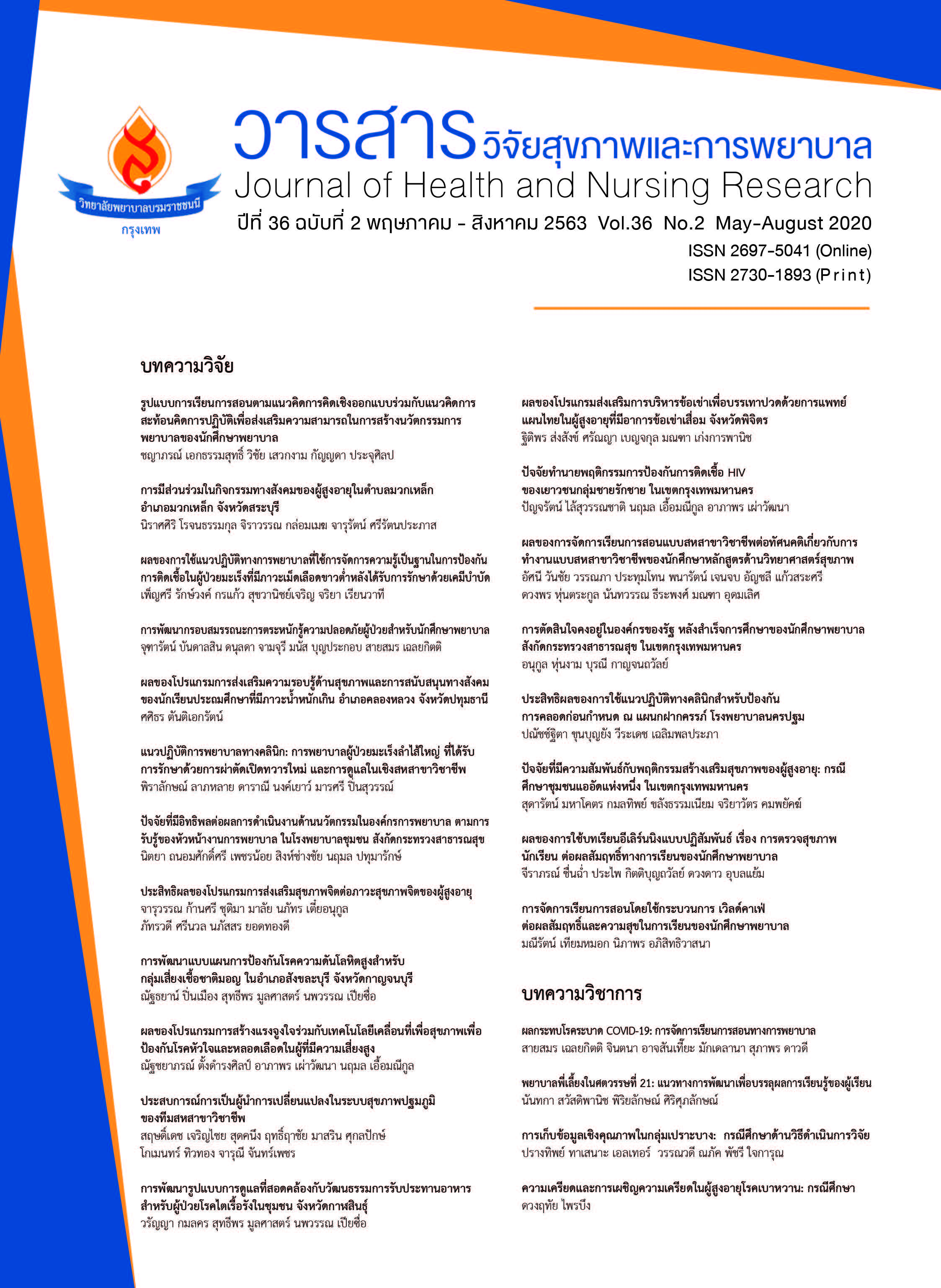การพัฒนากรอบสมรรถนะการตระหนักรู้ความปลอดภัยผู้ป่วยสำหรับ นักศึกษาพยาบาล
คำสำคัญ:
กรอบสมรรถนะ, การตระหนักรู้, ความปลอดภัยผู้ป่วย, นักศึกษาพยาบาลบทคัดย่อ
การวิจัยและพัฒนามีวัตถุประสงค์เพื่อพัฒนากรอบสมรรถนะการตระหนักรู้ความปลอดภัยผู้ป่วย และสร้างเครื่องมือประเมินสมรรถนะการตระหนักรู้ความปลอดภัยผู้ป่วยในนักศึกษาพยาบาล ดำเนินการวิจัย 4 ระยะ 1) การศึกษาเอกสารและสัมภาษณ์พยาบาลที่ได้รางวัลปฏิบัติการพยาบาลดีเด่นจำนวน 9 คน 2) นำข้อมูลมาสังเคราะห์เป็นกรอบสมรรถนะ 3) พัฒนาเครื่องมือประเมินสมรรถนะการตระหนักรู้ความปลอดภัยผู้ป่วยสำหรับนักศึกษาพยาบาล 4) ทดลองใช้เครื่องมือกับนักศึกษาพยาบาลชั้นปีที่ 2 จำนวน 20 คน ผลการศึกษากรอบสมรรถนะการตระหนักรู้ความปลอดภัยผู้ป่วยประกอบด้วย 2 องค์ประกอบ นำมาสร้างแบบประเมินสมรรถนะความปลอดภัยผู้ป่วย ดังนี้ องค์ประกอบ 1 การจัดการให้เกิดความปลอดภัยกับผู้ป่วย มีรายการประเมิน 4 ข้อ และองค์ประกอบ 2 การแก้ปัญหาเพื่อให้เกิดความปลอดภัยในการดูแลผู้ป่วย มีรายการประเมิน 3 ข้อ โดยมีเกณฑ์การให้คะแนนรูบริกแบบแยกองค์ประกอบตามระดับการตระหนักรู้ซึ่งแบ่งเป็น 5 ระดับ ตรวจสอบคุณภาพโดยผู้เชี่ยวชาญ พบว่าด้านความตรงเชิงเนื้อหารายการประเมินมีความสอดคล้องกับองค์ประกอบและจุดประสงค์การวัด เกณฑ์การให้คะแนนรูบริกของแต่ละระดับการตระหนักรู้มีความเหมาะสมสอดคล้องกับระดับคุณภาพ มีค่า IOC อยู่ระหว่าง 0.56-1.00 ด้านความตรงเชิงจำแนกเกณฑ์การให้คะแนนรูบริกโดยนำแบบประเมินไปทดลองให้คะแนนการตระหนักรู้ความปลอดภัยผู้ป่วยของนักศึกษาพยาบาล เปรียบเทียบค่ามัธยฐานของคะแนนการตระหนักรู้ของนักศึกษากลุ่มที่มีทักษะปฏิบัติการพยาบาลระดับดี ระดับพอใช้ และระดับต้องปรับปรุง ด้วยสถิติ Kruskal-Wallis H Test พบว่า มีความแตกต่างกันอย่างมีนัยสำคัญทางสถิติ (H(2) = 12.025, p = .002) และความเที่ยงระหว่างผู้ให้คะแนนคือ พยาบาลนิเทศกับผู้วิจัยมีความสัมพันธ์กันอย่างมีนัยสำคัญทางสถิติ (p<.05) โดยมีค่าสัมประสิทธิ์สหสัมพันธ์แบบเพียร์สัน (r) =.882 แสดงว่ากรอบสมรรถนะความปลอดภัยผู้ป่วยที่สังเคราะห์ขึ้นสามารถนำไปใช้ประเมินพฤติกรรมการตระหนักรู้ความปลอดภัยผู้ป่วย และใช้เป็นข้อมูลย้อนกลับให้คำแนะนักศึกษาพยาบาลเพื่อพัฒนาจุดเด่นและแก้ไขจุดบกพร่องในการปฏิบัติงาน
Downloads
เอกสารอ้างอิง
2. World Health Organization. Part B curriculum guide topics In: WHO patient safety curriculum guide multi-professional edition. Geneva: WHO Press; 2011.
3. Sammer CE, Lykens K, Singh KP, Mains DA, Lackan NA. What is patient safety culture? A review of the literature. Journal of Nursing Scholarship 2010;42(2):156-65.
4. National Health Security Office. NHSO Annual report fiscal Year 2016. Nonthaburi: National Health Security Office; 2016. (in Thai).
5. Tassniyom S, & Tassniyom N. WHO Patient safety guide: multidisciplinary edition (Thai version) volume 2. Nonthaburi: DeeWan Press; 2015. (in Thai).
6. Thailand Nursing and Midwifery Council. Competencies of registered nurses. 2nd ed. Bangkok: Siriyod Pring; 2010. (in Thai).
7. Supachutikul A. HA UPDATE 2016. Nonthaburi: The Healthcare Accreditation Institute (Public Organization); 2016. (In Thai).
8. Debourgh GA. Synergy for patient safety and quality: academic and service partnerships to promote effective nurse education and clinical practice. Journal of Professional Nursing. 2012;28(1):48-61.
9. Girdley D, Johnsen C, Kwekkeboom K. Facilitating a Culture of Safety and Patient-Centered Care Through Use of a Clinical Assessment Tool in Undergraduate Nursing Education. Journal of Nursing Education 2009;48(12):702-5.
10. Chaiaree C, Chiangkhong A. Development of A Raising Nurse’s Awareness and Developing Nursing Care for Patient Safety Program. Kuakarun Journal of Nursing. 2019;26(2):22-37.
11. Kaewtem, Y. Legal Liabilities and Considerations in Clinical Supervision of Student Nurses. Thai Journal of Nursing Council 2013;28(3):5-18. (in Thai).
12. Somcharoen N. Patient safety curriculum guide multi- professional (WHO): learning integration for the 21st century bachelor’s degree nursing curriculum. Journal of The Royal Thai Army Nurses 2015;16(3):1-7. (in Thai).
13. Frank JR, Brien S. The safety competencies: enhancing patient safety across the health professions. Ottawa, ON: Canadian Patient Safety Institute; 2009.
14. Cronenwett L, Sherwood G, Barnsteiner J, Disch J, Johnson J, Mitchell P, et al. Quality and Safety Education for Nurses. Nursing Outlook 2007;55(3):122-31.
15. Panthulawan S, Kunaviktikul W, Nantsupawat R, Srisuphan W. Development and psychometric testing of the nursing performance for patient safety scale. Pacific Rim International Journal of Nursing Research 2016;20(1):45-59.
16. Farthing WG. The psychology of consciousness. Englewood Cliffs, N.J.: Prentice-Hall; 1992.
17. Endsley MR. Toward a theory of situation awareness in dynamic systems. Human factors. 1995; 37(1):32-64.
18. Lesmond G, McCahan S, Beach D. Development of analytic rubrics for competency assessment: Higher Education Quality Council of Ontario; 2017.
19. Joungtrakul J. Sample size and sampling issues in qualitative research. Journal of Business Administration and Social Sciences Ramkhamhaeng University 2018;1(2):1-21. (in Thai).
20. Tangdhanakanond K. The measurement and evaluation of practical skill. Bangkok, Thailand: Chula Press; 2017. (in Thai).
21. Reason J. Human error: models and management. BMJ 2000;320(7237):768-70.
22. Lee NJ, An J, Song TM, Jang H, Park CSY. Psychometric evaluation of a patient safety competency self-evaluation tool for nursing students. The Journal of Nursing Education 2014;53(10):550-62.
23. Australian Commission on Safety and Quality in Health Care. Patient-centred care: improving quality and safety through partnerships with patients and consumers. Sydney: ACSQHC; 2011.
24. Turner S, Higginson J, Oborne CA, Thomas RE, Ramsay AIG, Fulop NJ. Codifying knowledge to improve patient safety: A qualitative study of practice-based interventions. Social Science & Medicine 2014;113:169-76.
25. Sayar S, Tahmasebi R, Azodi P, Tamimi T, Jahanpour F. The impact of tacit knowledge transfer through storytelling on nurses’ clinical decision making. Iran Red Crescent Med J. 2018;20(5):1-7.
ดาวน์โหลด
เผยแพร่แล้ว
รูปแบบการอ้างอิง
ฉบับ
ประเภทบทความ
สัญญาอนุญาต
บทความที่ได้รับการตีพิมพ์ เป็นลิขสิทธิ์ของวารสารวิจัยสุขภาพและการพยาบาล (วิทยาลัยพยาบาลบรมราชชนนี กรุงเทพ) ไม่สามารถนำไปตีพิมพ์ซ้ำในวารสารฉบับอื่น


















